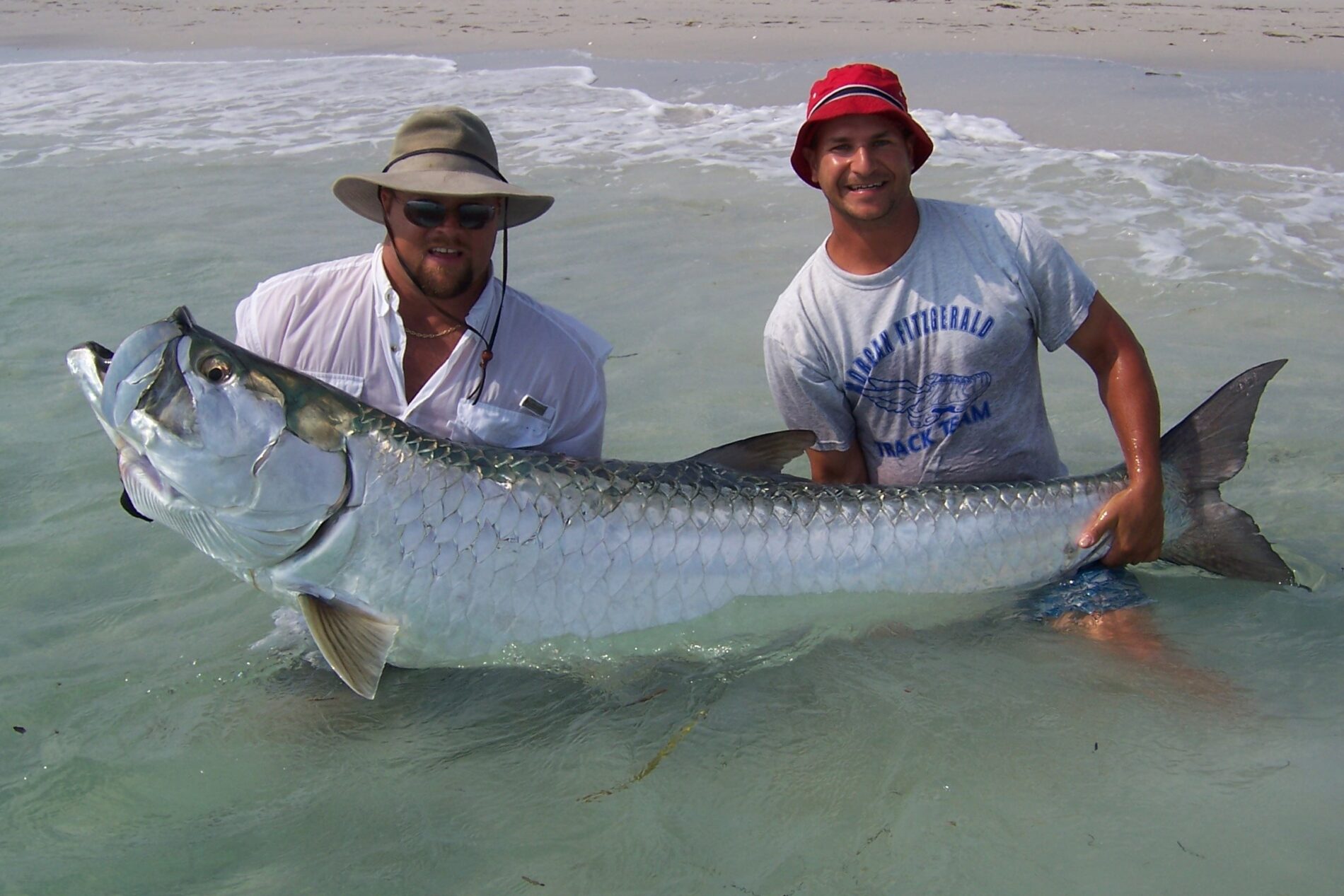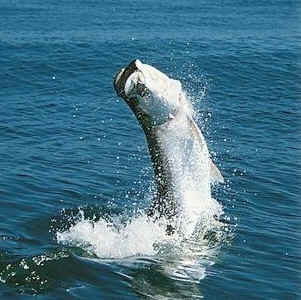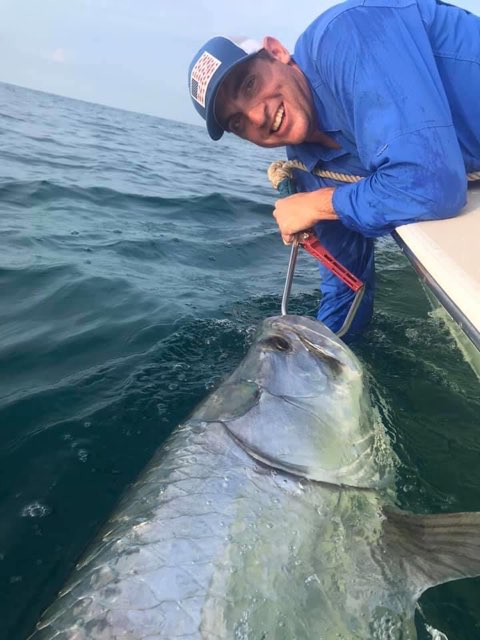
World-class tarpon fishing, with many world record line class, on spin, plug, fly and conventional gear is to be had. At any give time in the prime migration months of May, June and July, there are thousands of tarpon in and around the passes, beaches, and barrier islands ready to do battle with anglers from around the world. Our tarpon fishing charters catch these hard fighting acrobatic fish from 50 to 200 pounds! Hard runs, incredible leaps and gill rattling, heart-pounding excitement is to be had. The tarpon opens the gallon bucket of a mouth and inhales whatever is on the end of your line. You wait that long second for her to turn sideways, back to join her companions, then tighten the line, feel the ponderous weight, and snatch the point home with a mighty tug on the Rod, reel and line and hold on for the show! Be sure to bow to The King when this fish explodes from the surface. Conventional wisdom is that it takes about a minute per pound to put away a tarpon. This is not true if you get into the “down and dirty” mode that has make Capt Rich a renowned tarpon guide who has won many a tarpon tournament. It’s not the size of the dog in the fight, but the size of the fight in the dog. We will be fishing out of Tarpon Springs, Clearwater Beach, Palm Harbor, New Port Richey, Port Richey, Spring Hill, Brooksville and other Gulf coast beaches and flats this tarpon season with the main migration the months of May, June and July. We will be sight casting these pods of giant tarpon on an assortment of live and artificial baits. The fight of your life!
Absolute Florida Flats Fishing and Tarpon Fishing Charters offer a wide variety of Tarpon Fishing choices along the Florida Gulf Coast, Boca Grande area, back country, harbor, bays, sounds, passes and beaches. Tarpon tend to relocate up and down (North and South) on the Florida gulf coast during the season. Also the resident fish do as well throughout the rest of the year. They also use the sounds, harbors, bays and flats for comfort zones, and bite well in these places. As a result, Absolute Florida Flats Fishing and Tarpon Fishing Charters will be tarpon fishing on the beaches, bays, flats and barrier islands of the west central Florida gulf coast area as well as the southwest Florida gulf coast. We fish where the tarpon are happy.
The Florida west coast beaches from Homosassa to Marco Island, which includes Clearwater, Palm Harbor, Tarpon Springs, New Port Richey, Port Richey, Spring Hill, Brooksville, and St. Petersburg hold an incredible concentration of fish from early May to July. Yet on most weekday mornings, it’s rare to spot another boat as you cast your plug or live bait at seemingly unlimited schools of passing fish. When they are 30 yards away, cast your bait in their direction, throwing ahead of and beyond the school. Beach/flats tarpon fishing is buck fever time as the horse like fish roll toward the baits, gulping air through bucket-sized mouths. It’s remarkable fishing and yet only a few locals regularly enjoy it. It is ironic, considering that Boca Grande Pass, the world’s best-known and hardest fished tarpon spot, sits dead in the middle of this stretch of the FL gulf coast. While boats regularly bump rub rails to get to tarpon and chase back and forth in the big Pass, the thousands of west central FL tarpon that roam the beaches and flats are largely ignored.

Florida tarpon fishing charters can be good just about anywhere along the west central Florida coast beaches and flats. Capt. John Fischbach and other flats and beach tarpon-fishing guides find these tarpon (Silverking) in water from 5 to 25 feet and close to the main shoreline. They are thus accessible to boats of all sizes. They tend to travel parallel to these shorelines, moving steadily except for the occasional stops to feed or “Daisy chain.” The tarpon pod you want is the one that’s lazing also and showing often “happy poons” as the tarpon guides call them because they are much more likely to bite than tarpon that are moving along fast and showing infrequently. Capt. John Fischbach and other tarpon fishing guides use a number of live baits, mostly depending on the area fished. The baits include small blue crab, thread herring, sardines, mullet and pinfish. These are all durable and easy to cast. Tarpon also readily take sinking plugs such as the Mirro-Lure 65m and the D.O.A. Bait Busters, and they can be caught on flies as well.
Beach tarpon fishing charters are more of a stalk and hunt technique. It’s possible to see huge schools of tarpon cruising or daisy chaining on the surface just off the beach. Beach tarpon fishing requires stealthy approaches and good boat positioning for light tackle spinning enthusiasts. Tarpon fishing guides use a variety of artificial and live baits employing this method. Big threadfin herring, pumpkin seed shad, pinfish, and my favorite any time, blue crab and calico pass crabs. Size is important, as they should be about the size of a half dollar. Favorite artificials include 65m Fire-Glo, 65mr18 Mirrolure, 52M Mirrolure with dark green back and silver sides, and the D.O.A. Bait Buster in the dark back and silver sides and gold glitter sides. Always get in front and to the side and lead the tarpon with your cast or its over. There are proper tarpon fishing etiquette rules that everyone should know when beach tarpon fishing. Never run your outboard within the realm of tarpon, stay a half mile off and idle way around to intercept them, and then use your trolling motor to adjust. Never ease in on a school of tarpon that someone is working unless invited over and then use the proper stealthy method so as not to spook the fish. Keep your distance of at least 100 yards from anyone working a school. Do not chase a school of tarpon from behind as this will definitely spook these fish and give them lockjaw. Always put the most pressure possible on a tarpon. Be ready to “Bow to the King” and take as much time as needed to revive the fish afterward. Never pull adult size tarpon up onto the gunnel of a boat. You will have great photo opportunities along side the boat while reviving your trophy. These baits and rules apply to the shallow harbors, sand bars, sounds, backcountry and bays.
Florida Gulf Coast Tarpon fishing spans along the entire gulf coast of the state and these methods are employed throughout. For instance, Tampa Bay tarpon fishing has similar fishing to tarpon fishing Boca Grande. It usually begins in early spring around the bridges – Howard Franklin Bridge, Gandy Bridge and eventually the Sunshine Skyway Bridge. Other Tampa Bay tarpon fishing hot spots include areas off the Clearwater/St. Petersburg Airport runway hole, the mouth of the Manatee River, Terra Ceia Bay and Boca Ciega Bay. Tarpon fishing Tampa Bay employs similar methods along with anchoring up and chumming with cut shad, pilchards, cat fish tails and thread herring, soaking a piece of whichever fresh cut bait of choice on the bottom. Water temperature is key depending on where you are tarpon fishing. Tampa Bay tarpon fishing doesn’t stop at the Sunshine Skyway, as water temps climb the migrating tarpon and resident tarpon move to the beaches – Mullet Key, Passage Key, Anna Maria Island bar and Egmont Key. Tarpon fishing Tampa Bay and the ship channel to Egmont Lighthouse has similar crab runs on the new and full moons as well. The bait of choice again is the calico crab and blue crab in the half dollar size.
After the full moon in July most of the tarpon have usually spawned out offshore on the Florida Gulf coast somewhere along their migratory routes. Some fish return to estuary systems such as Charlotte Harbor, Ten thousand Islands, Tampa Bay and many of Florida’s Gulf coast river estuaries. The bigger tarpon usually migrate north around the panhandle, Louisiana, Texas and back to Central America. Other big tarpon on both Florida’s tarpon fishing coast migrate back to the Florida Keys and some Caribbean destinations. During the cooler months of the year, Absolute Florida Flats Fishing and Tarpon Fishing Charters catch these juvenile tarpon on light tackle 10 lb. Spinning gear. Tarpon from 10 lb to 50 lb are to be found in our home base area of New Port Richey, Tarpon Springs, Clearwater, Palm Harbor, Port Richey, Spring Hill, Brooksville, Tampa, and St. Petersburg. Up in the many rivers, some deepwater drag lined residential canals and power plants, these tarpon like to gorge themselves on the migratory baitfish, pilchards and some of the artificials mentioned earlier. The cooler the water temperatures, the smaller the bait, i.e. elephant eat peanuts.

COME ON & CATCH THE KING!
We can put together Florida tarpon fishing charter packages to suit any needs. We recommend several days of fishing to get the most that the area has to offer, but we can work you in whatever your schedule might be. We can also provide you with recommendations on accommodations and eateries. Fish from before sunup to sundown with easy access from Boca Grande, New Port Richey, Tarpon Springs, Clearwater, Palm Harbor, Port Richey, Spring Hill, Brooksville, Tampa, St. Petersburg and Orlando (Disney World area). So all you have to do to start your Florida tarpon fishing charter and this incredible journey is to make a call to Absolute Florida Flats and Tarpon Fishing charters.
We can put together Florida tarpon fishing charter packages to suit any needs. We recommend several days of fishing to get the most that the area has to offer, but we can work you in whatever your schedule might be. We can also provide you with recommendations on accommodations and eateries. Fish from before sunup to sundown with easy access from Boca Grande, New Port Richey, Tarpon Springs, Clearwater, Palm Harbor, Port Richey, Spring Hill, Brooksville, Tampa, St. Petersburg and Orlando (Disney World area). So all you have to do to start your Florida tarpon fishing charter and this incredible journey is to make a call to Absolute Florida Flats and Tarpon Fishing charters.
The tarpons are large coastal fish prized by anglers. They grow up to 8 feet in length and sometimes weigh over 200 pounds. When swimming in oxygen-poor water, tarpon can breathe air from the surface. There are two species in a single genus MEGALOPS in the family MEGALOPIDAE, ONE NATIVE TO THE Atlantic ocean and Gulf of Mexico and south, and the other to the Indo-Pacific oceans. The genus name derives from the Greek adjective “megalo” meaning “large,” and the noun “opsi,” meaning “face.” Tarpon are superb sport, with a long lasting, powerful fight enerally including several outstanding leaps. While edible, they are seldom eaten, as their flesh is considered too oily and boney to be palatable. Atlantic tarpon, MEGALOPS ANTLANTICUS is a famous sport fish. Indo-Pacific tarpon, MEGALOPS CYPRINOIDES, is a lesser-known and smaller fish.
The Atlantic tarpon inhabits coastal waters, estuaries, lagoons, and rivers. It feeds on various fish and crabs. It is capable of filling its swim bladder with air and absorbing oxygen from it. Specimens have been recorded at up to 98 inches in length and weighing up to 350 pounds. The Atlantic tarpon is also known as the SILVERKING. In appearance it is greenish or bluish on top and silver on the sides. The large mouth is turned upwards and the lower jaw contains an elongated bony plate. The last ray of the dorsal fin is much longer than the others, reaching nearly and toward the tail.
The Atlantic and Gulf of Mexico tarpon is found in the Atlantic and Gulf of Mexico typically in tropical and subtropical regions, though it has been reported as far north as Nova Scotia and the Atlantic coast of Southern France, and as far south as Argentina. As with all Elopiformes, it is found in coastal areas, spawning at sea, a little way offshore. Diet includes smaller fish and crustaceans.
The tarpon is considered one of the great saltwater game fishes, not only because of the size it can reach and its accessible haunts, but because of its fighting spirit as when hooked, it is very powerful, making spectacular leaps into the air, clearing it’s whole massive body from the water. In Florida, a special tag (permit) is required to kill and keep a tarpon; so most tarpon fishing here is catch, photo and release.
Although a variety of methods are used to fish for tarpon (bait, lure and fly on spinning, conventional or fly rod) the most popular method is using lures or bait on heavy spinning or conventional gear. Many anglers prefer this as a more surefire method to catch tarpon and a memory. Usually the eels are filled with line from 30 to 80 pound test (14 to 36 kg) although 50 lb seems to be the most popular. Although a great deal of fun, the outcome is less often in doubt, unlike fly fishing with light 20 pound (9.1 kg) test, and getting a tarpon to take a crab, shrimp, mullet, pinfish, pilchard or a thread herring is easier than an artificial fly. Flats fishing with a fly rod is a sport akin to hunting, combining the best elements of hunting with fishing. A normal tarpon fly rod outfit uses 10 to 12 weight rods and reels, spooled with the appropriate backing line attached to the fly line of choice, using a 12 to 20 pound class tippet before the 80 pound to 100 pound shock leader. Truly light tackle fishing where the fish may weigh 10 times or more than the breaking strength of the tippet line weight. Typically an angler stations himself on the bow of a shallow water boat, known as a “flatskiff” and with the aid of a guide searches for incoming tarpon on the flats and inshore sand bars of the ocean or gulf that are very shallow, typically no more than 3 to 4 feet (0.91 – 1.2 m) deep.
When a school or pod of tarpon is sighted, the guide positions the boat to intercept the fish. The angler usually has no more that 6 to 10 seconds to false cast out enough fly line and make a very accurate cast to these fast moving fish. Accuracy and speed are paramount, but the task is compounded by the inevitable excitement and nervousness of seeing a school of fish that may to 180 pounds (82 kg) bearing down on the angler. Once the cast is made, the fly is retrieved and hopefully a tarpon inhales the fly. The hookset is difficult due to the hard mouth of the tarpon, which has been likened to the hardness of concrete. For that reason many tarpon throw the hook on the first few jumps and so many times it is asked of an angler “How many tarpon did you jump?” rather than how many they caught. If the hook stays secure the fight is on. Tarpon have tremendous endurance and are one of the most exciting gamefish to fight; frequent spectacular jumps, long runs, and stubborn bulldogging are all part of the experience. Although a good and skillful angler can usually land a tarpon in less than an hour, novice anglers on fly average takes longer than one to three hours and this is hard on the fish.
| BINOMIAL NAME: | Megalops Atlanticus |
| KINGDOM: | Animalia |
| PHYLUM: | Chordata |
| CLASS: | Actinopterygii |
| ORDER: | Elopiformes |
| FAMILY: | Megalopidae |
| GENUS: | Megalops |
| SPECIES: | Megalops Atlanticus |
The rates below for Tarpon fishing charter is at Boca Grande
If you would like to book more than 1 charter in the day, please call for discount. Other excursions available by request. Charter times are:
- 3pm – 9pm
- 9pm – 3am
- 3am – 9am
| Type of Charter | Duration | First 2 ppl | Each Additional Person |
| 1/2-Day | 4 Hours | $700 | $100 per |
| 3/4-Day | 6 Hours | $800 | $100 per |
| Full-Day | 8 Hours | $900 | $100 per |
* Prices are subject to change without notice.
